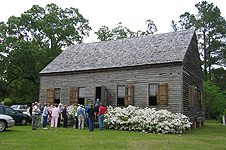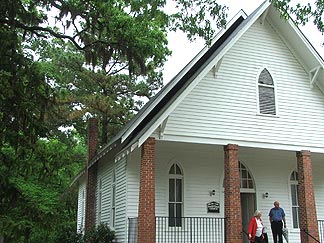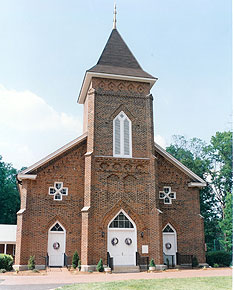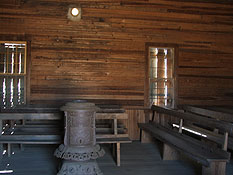Back
to Newsletter List
____________________
Spring
2006 Newsletter
Treasures
in Bladen County
Elizabethtown, April 22, 2006
Brown Marsh Church,
built ca. 1818
Most of the early Presbyterian congregations in rural North
Carolina began in homes or brush arbors, moved into log structures,
then built a frame church, and when they could afford to, they
replaced it with a finer church of brick or stone. Some continued
to use the frame building but covered the walls with brick veneer
outside and plaster inside. Very few of the frame “second
churches” have survived in their original form.
| |
 |
|
|
Brown
Marsh Church |
On Saturday, April 22nd,
however, our Spring Meeting will highlight an excellent example
— Brown Marsh Church. It is at least
the second building on the site, and the cemetery dates to the
1780s. Building of the present church is believed to have begun
in 1818, and it was dedicated in 1828. In 1871 the congregation
moved to nearby Clarkton, and in 1886 the name was changed to
Clarkton Presbyterian Church. The unpainted frame church was
maintained, however. In 1911 Wilmington Presbytery organized
a second Brown Marsh Congregation, which held services there
until 1949. The church and cemetery now belong to Coastal Carolina
Presbytery and are on the National Register of Historic Places.
Bladen County began as Bladen
Precinct in 1734. Bisected by the Cape Fear River, it was settled
first by English planters and traders and then by many Scots
after 1739. In 1756 Hugh McAden traveled through the area twice
and preached to a number of congregations gathered in homes.
Clarkton Presbyterian Church (formerly Brown Marsh) traces its
organization to McAden’s visit and will celebrate its
250th anniversary this year.
In such an historic area,
this spring meeting will be a mini-tour. We will begin at the
Elizabethtown Presbyterian Church (1825) with registration at
9:30 and the program beginning at 10 a.m. From there we will
car-pool to Brown Marsh Church and cemetery, only a few miles
away. Lunch back in Elizabethtown will be followed by our annual
business meeting, election of officers, and the presentation
of our church history award.
| |
 |
|
|
Beth
Car Church |
After lunch we will drive
up Highway 87 to Tar Heel and the lovely old church of Beth
Car. There is no official date of organization for this church,
but it is known to have been there by 1819 at least. Governor
John Owens’s slave Moreau, formerly Omar
Ibn Said, an African prince who had been educated in Arabic,
worshipped at Beth Car.
As a final treat, we will
drive just across the river from Tar Heel to Harmony
Hall, built ca. 1768 by Col. James A. Richardson. Francis
Asbury, America’s first Methodist bishop, visited this
home in 1787. The property is owned by the Bladen County Historical
Society, and a number of buildings have been moved there for
preservation. These include the Shaw-McMillan House (1784),
a log home (1835), a district school (1880s), a general store
(1890s), a former Freewill Holiness Church (ca. 1900), and others.
Admission is free, but contributions are welcome.
Resistance Grows
to Announced Closing of Historical Foundation at Montreat
The announced closing by December 2006 of the Historical Foundation
at Montreat has prompted overtures from twenty-one presbyteries,
including all presbyteries in North Carolina. All overtures
are asking the General Assembly, meeting in Birmingham in late
June, to halt further steps by the Committee on the Office of
the General Assembly toward closure, and to find ways to preserve
the Historical Foundation at Montreat. COGA’s plan is
to transfer the denominational records to Philadelphia and other
materials to Columbia Seminary. However, the many church records
and manuscripts that are only on deposit may be returned to
their donors and dispersed. Presbyterians and scholars generally
will lose a very important resource if the center in Montreat
is closed.
The historical centers in
Philadelphia and Montreat are funded through per capita assessments
from the churches, and these funds are said to be inadequate
for the administrative functions of our governing bodies. The
Friends of the Historical Foundation at Montreat have formed
a Campaign Committee to seek conditional pledges toward operating
expenses and an endowment, in the event that the General Assembly
allows the Historical Foundation to continue its operation. It
is important that even small pledges are made, to demonstrate
that the Foundation has wide support throughout the southeast.
The Rev. Thomas K. Spence, former president of the NCPHS, is
serving as chair of this committee, and our current president,
Dr. Donald Saunders, is also serving on this committee. Those
wishing to pledge or participate in this campaign should contact
Tom Spence, 294 Fairway Lane, Sanford, NC 27332; tel. (919)
498-2159; e-mail: tom-brenda@charter.net.
Fall Tour 2005 in Rowan and Iredell Counties
The stream of Scotch-Irish and German settlers coming from Pennsylvania
down the Great Wagon Road began to move into western North Carolina
in the mid-1740s, in search of less expensive land. Many settlers
found Rowan and Iredell Counties very appealing. The first known
Presbyterian congregation in the area was Cathey’s Meeting
House (ca. 1748), which became Thyatira Presbyterian Church
in western Rowan County. In 1751, Rev. John Thomason established
congregations that met at “preaching stands.” These
were precursors of the following congregations: Rocky River,
Centre, Hopewell, Third Creek, and Fourth Creek. Several years
ago our group visited Rocky River and Hopewell, two churches
that have embraced the celebration of heritage in their worship.
Third Creek Church in Cleveland,
NC, worships in a sanctuary that dates to 1835. Their minister,
Rev. Mr. David Carriker, was our guide and commentator during
the bus tour on Saturday. He also catalogued the Third Creek
cemetery, for which he received an award from our society several
years ago.
Ms. Ashley Shoaf, Ms. Suzanne
Casey, Rev. Mr. Malcolm Bullock, and other members First Presbyterian,
Salisbury, greeted us warmly at the opening dinner and presentations
that followed. Organized in 1821, its first minister had come
to Salisbury as teacher of the classics at Salisbury Academy.
An excellent history of the church was published in 1996 by
Mrs. Jo White Linn, who also received an award from this society.
She is a life member. After dinner Rev. Mr. David Carriker spoke
to us about the history of both the antebellum churches and
the segregated churches that were formed after the Civil War.
| |
 |
|
|
Thyatira
Church |
On Saturday our bus tour
took us to the earliest organized Presbyterian church in the
western part of North Carolina — Thyatira (1748). David
Carriker’s running commentary enhanced our enjoyment of
the trip. Back Creek (PCA) was formed in 1805 by a group of
“shouting Presbyterians” from Thyatira. Centre Church
(1751) was founded at the same time as Third Creek by John Thomason
and has many interesting parallels. From there we traveled to
Cameron Church, a lovely and historic African-American church
where we enjoyed a sandwich lunch as we talked with church members.
Members of Unity Church in Woodleaf, organized in 1788, greeted
us warmly as the tour ended. Many of us strolled through the
cemetery before returning to the bus. We passed several interesting
houses and learned about their histories through the story-telling
gifts of Rev. Carriker.
President Don Saunders’
Letter Regarding Department of History – Montreat Branch.
Last October our president, Dr. Donald Saunders, sent the following
letter to the Stated Clerk of the General Assembly, to the denomination’s
Department of History in Philadelphia, and to the executives
of each presbytery in North Carolina.
To Whom it May Concern:
On October 8, 2005
the executive committee of the North Carolina Presbyterian
Historical Society (NCPHS), at its regular fall meeting, voted
to protest the recent decision to close the Historical Foundation
at Montreat, and authorized its president to communicate this
protest to appropriate agencies.
The NCPHS has more
than 170 members and a mailing list of some 1000 persons and
groups. Since its inception more than forty years ago, the
Society has sought diligently to further the understanding
and appreciation of the history of North Carolina Presbyterianism.
Its members are scholars, pastors, archivists, writers, genealogists,
and others who have for decades found the resources of the
Historical Foundation to be crucial to their work.
We are deeply disappointed
that the Presbyterian Church USA is failing to find ways to
keep open this valuable repository of its regional history.
It is our sincere hope that it is not too late to reverse
this decision. Over many years generous donors and diligent
collectors have assembled at Montreat a set of resources which
simply cannot be duplicated anywhere else, nor be used as
effectively in any other locale. The dispersal of this collection
marks a breach of faith with generations of loyal Presbyterians
who have sought to preserve there a record of their work at
home and abroad.
The NCPHS encourages
the Friends of the Historical Foundation at Montreat, Inc.,
and any other agencies to work to overturn the recent decision
and prevent the dispersal of the Historical Foundation at
Montreat’s valuable resources.
Donald B. Saunders,
PhD
President, North Carolina Presbyterian Historical Society
On October 25, 2005, the
board of Friends of the Historical Foundation at Montreat, Inc.,
voted unanimously to respectfully appeal the COGA decision and
its subsequent implementation.
In a letter dated November
14, James Cogswell, chairperson of the Friends Board, said:
“The action was taken in light of the fact that COGA has
not had opportunity to consider other possible options that
would both save the Historical Foundation and relieve the Office
of the General Assembly of responsibility for its support. We
firmly believe that the closing of the Historical Foundation
and the dispersal of its unique holdings is such a serious matter
that it deserves a decision, not only by COGA, but by the General
Assembly itself. Therefore we have requested that the COGA action
be reconsidered, and that any implementation of that action
be halted until the General Assembly may give this matter its
serious consideration.”
The Friends are drawing up
a plan for the Foundation to continue its unique role as an
educational and research center for the Presbyterian Church
(USA) and its partner churches around the world. In addition
to serving as a regional historical center, the Foundation would
work with the Montreat Conference Center and Montreat College
toward becoming a Center for the Study of World Mission and
Evangelism. For more information, please contact the Friends
of the Historical Foundation at Montreat, P.O. Box 207, Montreat,
NC 28757, fhfm@bellsouth.net.
Award for History
of the First Presbyterian Church, Rocky Mount
This year our society’s church history award is going
to David A. Jones for his book, A History of the First Presbyterian
Church of Rocky Mount, 1878-2003. The award will be presented
at our spring meeting, April 22nd.
NCPHS presents awards each
spring for outstanding books or other projects on church history.
Has your congregation compiled or published a history, made
a history quilt, or established a history collection? Don’t
keep it a secret! Document it, and let Joy
Heitmann know.
Deaths
Kelly G. and Mae M. Watts of Taylorsville, NC died in 2005.
No details were provided, except that Ms. Watts was 92 years
of age.
Happy 250th Anniversary
Red House Church, Semora, is noted as burial place of its ever-energetic
Scottish pastor, Rev. Dr. Hugh McAden, who visited or founded
an almost endless list of churches in the mid-Atlantic states
during the mid to late 1700s. Ms. Cathy Long, Ms Lib McPherson,
and others are documenting the church’s history as the
October 2006 celebration approaches.
Buffalo Presbyterian
Church, Greensboro, also traces its beginnings to the
colonial era. Noted minister and educator, the Rev. Mr. David
Caldwell, was an early pastor. Herb and Jenny Tucker of our
society have been instrumental in achieving Historical Register
recognition in 2002 and other accolades.
* * * * *
The Presbytery of
Coastal Carolina is compiling its history, especially
consolidation of four earlier presbyteries into the present
body. Martha McLeod, a life member of NCPHS is one of the leaders
of the project. Martha’s brother, the late Rev. Dr. John
D MacLeod, Jr., was interim executive beginning in 1991 and
shepherded the merger to fruition. The presbytery office is
in Elizabethtown, near the site of our spring meeting.
Editor’s Note
by Sally MacLeod Owens
I regret that I will miss the spring
meeting, but I will be sporting a different hat that day as
“Coach Terry’s Mom” at a Special Olympics
swim meet.
Please send news of churches,
church histories and other suggestions. Ideas are always welcome.
Reprints of "Report
from 2004 Presbyterian General Assembly" regarding the
future of the Presbyterian Historical Society are available
at $1.00 each to cover copying and postage. A copy of a sample
overture to General Assembly can also be purchased. As with
other reprints, contact Sally MacLeod Owens. You may send your
request and additional money with your tour registration.
Foote’s Sketches
of North Carolina, 2nd ed., by Dr. Harold James Dudley
is available again.
With permission of the late
Dr. Harold J. Dudley, the society is reprinting a speech he
first gave in 1964 entitled “Toryism in North Carolina.”
If you are interested in those who remained loyal to the
British Crown during the American Revolution (as did many Scots
from the areas of our 2003 meetings) and if you would like a
copy, please send $2.00 to Sally.
Copies of Great Wagon
Road maps are available for $1.00. Many churches in
central North Carolina have their roots in the Shenandoah Valley.
A reader aptly noted that the Great Wagon Road was the interstate
highway of the eighteenth and early nineteenth centuries. Interstate
81 does indeed follow the center of the path the Scotch-Irish
settlers followed.
| |
 |
|
|
Interior
of Brown Marsh Church |
The Battle of Elizabethtown
August 29, 1781
Elizabethtown was established as the county seat in 1773. Because
of the number of Scots in the area, it was a Tory stronghold
during the American Revolution. In August 1781 about 60 patriots
from Duplin County forded the Cape Fear at night, holding their
clothing and ammunition above their heads. In the early morning
they launched a surprise attack on Elizabethtown. The approximately
300 defenders, mostly Highland Scots, fought but were routed
after their commanders were killed. Many leaped into the steep
ravine leading down to the river, known since as Tory
Hole. The patriots then retreated to safe territory across
the river, taking with them a number of freed patriot prisoners
and a stockpile of guns, ammunition, and provisions.
Directions to Brown Marsh Church
(in case you arrive late or get separated….):
• From Elizabethtown Presbyterian
Church, go left (east) on Broad Street to Hwy 701 (Poplar St.).
• Turn right (south). Continue almost
4.8 miles to Harrelson Road on your left.
• Turn left and proceed 1.9 miles
to T-junction with Mercer Mill - Brown Marsh Road.
• Turn right and go almost 2 miles.
Brown Marsh Church will be on your left. Pull inside the gate
and park on the grass.
• Directions to The Barn Restaurant
• From Brown Marsh, turn right on
Mercer Mill – Brown Marsh Road. Proceed about 2 miles
to Harrelson Road on the left.
• Proceed on Harrelson to Hwy 701.
Turn right on 701 to Elizabethtown.
• Turn left on Broad St. (Hwys 41
& Bus. 87). Go 0.8 mi., passing the Presbyterian Church
on the way. The Barn is on the right.
Need a Ride to Elizabethtown?
We may not be able to help, but if you need a ride, please call
our secretary, Brenda Spence, at 919-498-2159. It is possible
that someone who is planning to go would be able to take you.
She could give you the names of some people to ask.
Back
to Newsletter List

